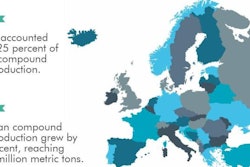
Newly published research from the United Kingdom reveals that the moisture content of wheat at harvest and the presence of a fungus can have significant impacts on the performance of growing broilers.
The report, published by national levy board Agricultural and Horticultural Development Board (AHDB) Cereals & Oilseeds group, includes several related studies that investigate the prediction of nutritive value of wheat for broilers, and the role of novel factors in the grain on the birds’ growth.
This project was one of three launched by Home Grown Cereals Authority (forerunner of AHDB Cereals & Oilseeds) in 2013. With additional funding from the government and industry, the overarching aim of the research was to develop improved ways to measure the nutritive value of grains and oilseeds.
Involved in this latest project were researchers from Agri-Food and Biosciences Institute (AFBI) and Moy Park Ltd. in Northern Ireland, and Harper Adams University in England.
The research and findings
First, the researchers aimed to validate existing equations based on Near-Infrared Reflectance Spectroscopy (NIRS) analysis of wheat to predict the performance of commercial broilers fed the same wheat samples, which totaled 26 and had been sourced from the U.K., France, Germany and the U.S. Each wheat sample was analyzed for specific weight, in-vitro viscosity, and a number of chemical components that included energy, starch, protein and amino acids. Levels were also measured in each wheat of the mycotoxins deoxynivalenol (DON), zearalenone (ZON) and ochratoxin A and B, as the researchers involved found no published literature on the use of NIRS to predict the concentration of these mycotoxins in whole wheat.
They also measured Microdochium nivale, a fungal infection of wheat causing ear blight. While it does not produce mycotoxins, microdochium does reduce wheat yield and individual grain weight yet its effects on broiler performance have not been quantified.
As might be expected, broiler growth was affected by wheat type. Wheat moisture level at harvest was found to be positively correlated with liveweight gain (LWG), which the scientists attributed to beneficial effects of either the drying process or early sprouting. DON and ZON had variable effects on performance, while microdochium concentration had a weak but positive effect on feed efficiency. In these studies, wheat specific weight had no significant effects on feed intake, LWG or feed efficiency.
The scientists also developed equations based on NIRS analysis that predicted the feed intake, LWG and feed efficiency of broilers in trials at AFBI. However, the relationships were weaker for commercial birds in a trial at Moy Park.
Authors of the full report, titled “Development of an accurate means to predict the nutritive value of wheat for broilers and an investigation of novel wheat factors on broiler performance” are M.E.E. Ball, J. Sloss, A. Catlett, R. Garcia, V. Pirgozliev, and H. Massey-O’Neil.
Increasing complexity in the global pattern of mycotoxins is creating greater challenges for poultry and livestock nutritionists, according to Dr. Eva Maria Binder, chief scientific officer with Erber A.G. at an event organized by WATT Global Media and sponsored by Biomin two years ago. Binder cited the example of Fusarium graminearum displacing Microdochium nivale and Fusarium culmorum.
















